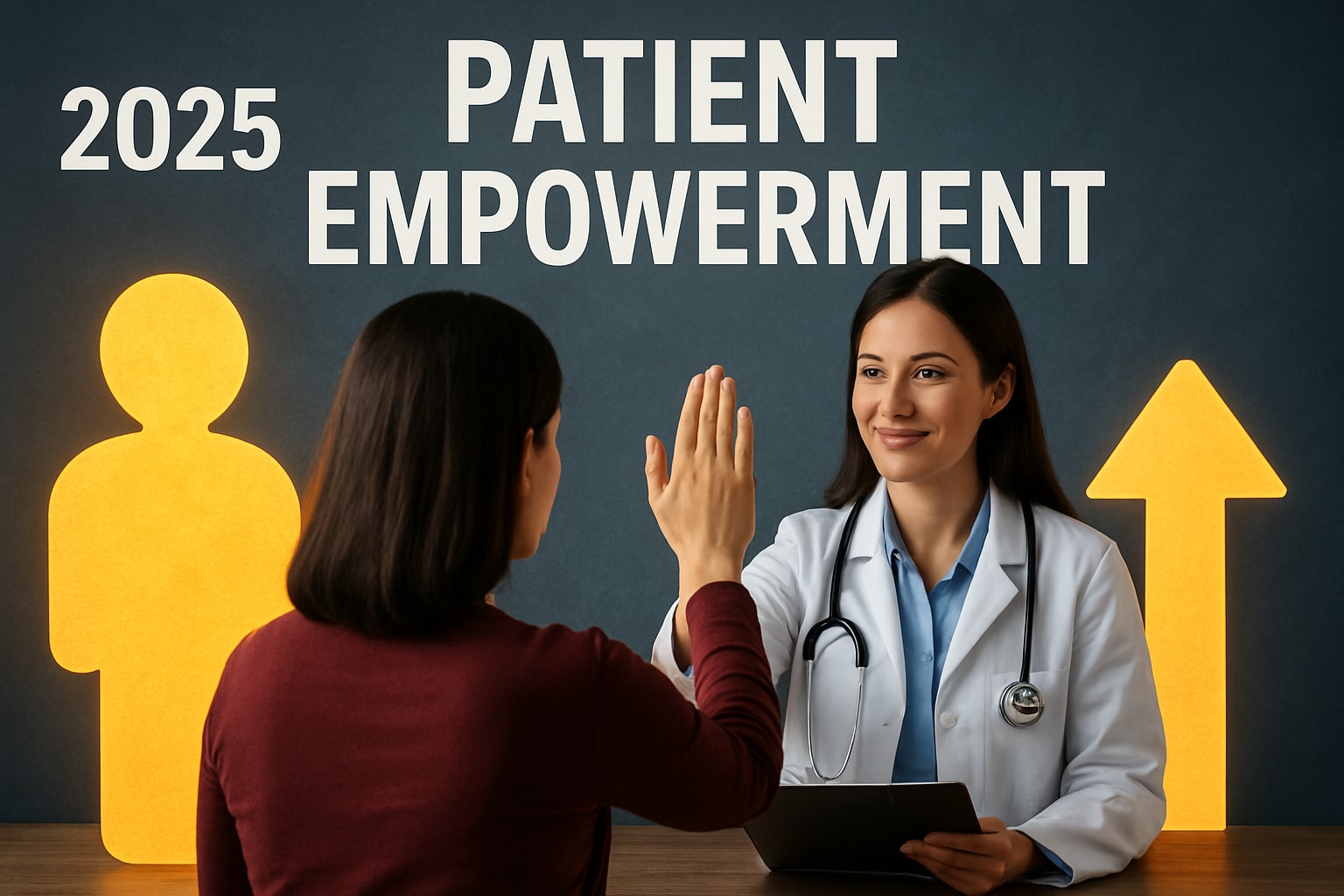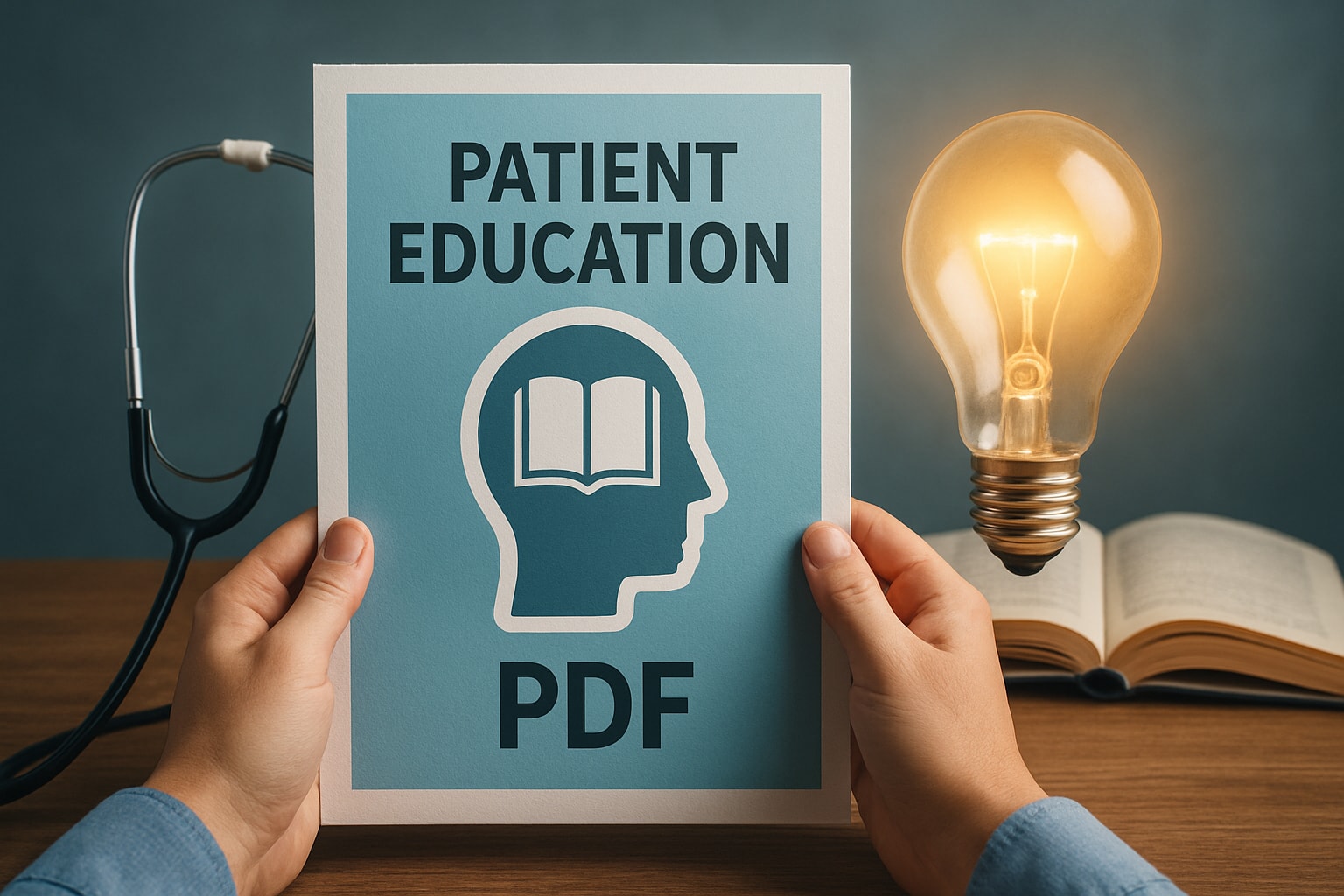Imagine a healthcare landscape in 2025 where patients are not merely recipients but active partners in their care. In this new era, patient empowerment shapes every interaction, equipping individuals with the knowledge, confidence, and practical tools to make informed decisions about their health. Why is this shift vital now? As the need for patient-centered care grows, empowered patients achieve better outcomes, greater satisfaction, and even cost savings. This essential guide will reveal what patient empowerment means today, the forces driving it, actionable steps for individuals and providers, the latest technologies, and the measurable impact on care quality.
Understanding Patient Empowerment in 2025
Patient empowerment is reshaping healthcare in 2025, placing individuals at the center of their own health journey. This concept goes beyond simply receiving care; it is about patients actively participating in decisions, managing their health, and collaborating with providers. Unlike patient engagement or involvement, which focus on participation or communication, patient empowerment emphasizes the ability and confidence to make informed choices and take meaningful action.
Traditionally, healthcare viewed patients as passive recipients. Over time, the approach shifted. Today, patient empowerment means patients are recognized as active partners in care. This evolution reflects a broader movement toward patient-centered care, where respect for individual preferences and values is essential.
Four core elements define patient empowerment: information, access, engagement, and agency. Information equips individuals with the knowledge they need. Access ensures the ability to obtain services and resources. Engagement involves patients in every step of decision-making. Agency supports autonomy and self-management. Organizations such as Wolters Kluwer highlight these pillars as fundamental for true empowerment.
Health literacy plays a critical role in patient empowerment. When patients understand their conditions and treatment options, they can confidently participate in their care. Accessible, plain-language resources and effective communication from clinicians are vital. Mutual respect and collaboration between patients and healthcare professionals further strengthen empowerment, as noted in research published by BMC. These relationships create a supportive environment where patients feel heard and valued.
The benefits of patient empowerment are measurable. Studies from BMC and PLoS One show that empowered patients adhere more closely to treatment plans, report higher satisfaction, and experience better health outcomes. For example, a patient using a digital tool to track symptoms and share updates with their care team can identify issues early and make informed decisions. This proactive approach reduces complications and enhances well-being.
Clear conceptual definitions of patient empowerment are essential for both research and practice. When healthcare teams and policymakers agree on what empowerment means, they can design effective interventions and measure their impact accurately. Resources such as patient education materials for empowerment support this process by providing practical tools that bridge knowledge gaps and foster autonomy.
In summary, understanding patient empowerment in 2025 requires recognizing its unique attributes, appreciating its evolution, and committing to its core elements. This clarity ensures that both patients and providers can work together to achieve better health outcomes and a more responsive healthcare system.

The Forces Driving Patient Empowerment in 2025
The landscape of patient empowerment in 2025 is shaped by a convergence of powerful forces. These drivers are reshaping healthcare, moving it from a provider-centric model to one where patients play an active, informed role in their own care. Understanding what is fueling this shift helps providers, organizations, and individuals anticipate trends and leverage opportunities for better health outcomes.

Societal trends are at the forefront of patient empowerment. An aging global population is increasing the prevalence of chronic diseases, prompting greater demand for personalized and proactive care. People are living longer, often with complex conditions that require ongoing management. As a result, patients and their families seek more information, choices, and involvement in their care plans. Policy and regulatory changes have further accelerated this trend. Governments and health authorities worldwide are enacting laws that protect patient rights and promote shared decision-making, ensuring individuals have a voice in their treatment options. These shifts are making patient empowerment not just an ideal, but a requirement for modern healthcare systems.
Technology is another major catalyst for patient empowerment. The COVID-19 pandemic dramatically expanded the use of telehealth and digital health solutions. Virtual visits, remote monitoring, and self-care tools became essential for keeping patients connected to care during lockdowns and social distancing. Today, artificial intelligence, wearable devices, and personalized health platforms are providing patients with real-time data and tailored recommendations. For a deeper look at how these advancements are shaping care, see Healthcare Technology Trends 2025. These innovations help patients monitor their symptoms, communicate with providers, and make informed decisions, strengthening their role as partners in health.
Access to credible health information and the rise of online communities have also played a crucial role in patient empowerment. Patients now have unprecedented access to medical knowledge, symptom checkers, and support groups via the internet. This abundance of information enables individuals to educate themselves, ask informed questions, and advocate for their needs. Online forums and social media groups connect people with similar conditions, allowing them to share experiences and strategies. These resources not only improve health literacy, but foster a sense of agency and belonging that is essential for ongoing engagement in care.
Healthcare providers and organizations are adapting to support patient empowerment. Many are implementing training programs focused on communication, empathy, and patient engagement strategies. Hospitals and clinics are integrating patient portals, remote monitoring systems, and digital tools into their workflows. National health systems are leveraging these platforms to streamline care coordination and support self-management. For example, patient portals now allow individuals to access test results, schedule appointments, and message providers at their convenience. This shift is reflected in growing interest and research, as seen in over 46,000 accesses to BMC’s studies on empowerment. These efforts underscore the argument that patient empowerment is not just beneficial, but essential for sustainable, cost-effective healthcare. Empowered patients are more likely to adhere to treatment, experience greater satisfaction, and achieve improved health outcomes.
The Pillars of Patient Empowerment: Information, Access, Engagement, and Agency
Patient empowerment rests on four foundational pillars: information, access, engagement, and agency. These pillars work together to transform patients from passive recipients into active partners in their care. Understanding each element is key to unlocking the full potential of patient empowerment in today's healthcare landscape.

Information: Building Health Literacy
Accessible, clear health information is the first step toward patient empowerment. When patients understand their health conditions, treatment options, and self-care strategies, they are better equipped to make informed decisions.
Digital resources, plain-language guides, and effective clinician communication are essential tools. For example, tailored patient education materials help individuals grasp complex medication regimens, reducing errors and improving outcomes. Evidence shows that patients with higher health literacy have better adherence, fewer complications, and greater satisfaction with care.
Addressing disparities in health literacy is also vital. Not all patients have equal access to reliable health information. By offering diverse educational tools, such as home health education resources, healthcare providers can support equitable patient empowerment and bridge knowledge gaps.
Access: Removing Barriers to Care
True patient empowerment requires removing barriers that prevent individuals from receiving the care and information they need. Financial constraints, geographic distance, and limited technology access can all hinder patient participation.
Telemedicine and mobile health services have expanded access, especially for those in rural or underserved areas. For instance, rural patients can now consult specialists remotely, saving time and travel costs. The widespread adoption of online health portals after the pandemic has further increased access to critical health information.
Equitable access is essential for all patients to benefit from empowerment initiatives. Healthcare systems must continue to identify and address these barriers, ensuring every patient can fully engage in their care journey.
Engagement: Fostering Active Participation
Engagement means patients take an active role in their health decisions. In the context of patient empowerment, this involves shared decision-making, open communication, and collaborative care planning.
Healthcare providers can use tools such as interactive care plans and symptom trackers to encourage participation. Shared decision-making models help patients weigh the benefits and risks of different treatment options, leading to choices that align with their values and preferences.
Research shows that engaged patients are more likely to adhere to treatment regimens and experience better health outcomes. Importantly, engagement is not one-sided. Providers must create an environment where patients feel comfortable asking questions and expressing concerns, making engagement a true partnership.
Agency: Supporting Self-Management and Autonomy
Agency is the ability of patients to set goals, make choices, and manage their health independently. It is the culmination of the other pillars of patient empowerment, enabling individuals to take meaningful action.
Tools like apps for tracking blood sugar, wearable devices, and self-management workshops empower patients to monitor progress and adjust behaviors. For example, people living with diabetes who use digital tools for self-monitoring often achieve better control and avoid hospitalizations.
Self-management programs have been shown to reduce emergency room visits and improve quality of life. By supporting autonomy, healthcare providers reinforce patient empowerment and foster long-term health success.
Step-by-Step Guide to Patient Empowerment in 2025
Empowering patients in 2025 is a dynamic, multi-step process that prioritizes knowledge, access, engagement, and autonomy. This guide outlines practical steps for patients, families, and healthcare providers to foster true patient empowerment at every stage of the health journey.

Step 1: Assessing Health Literacy and Information Needs
The first step in patient empowerment is understanding each person's baseline health literacy and preferred learning style. Providers can use validated tools to assess comprehension and tailor communication accordingly. Some patients may prefer visual aids, while others benefit from written guides or interactive content.
Clinics increasingly offer personalized educational materials after assessing needs. This ensures patients receive relevant, understandable information that supports patient empowerment from the start. Personalization is key, as it increases engagement and helps patients retain essential knowledge. When patients understand their health status and care instructions, they are better equipped to participate in decisions, setting the foundation for ongoing empowerment.
Step 2: Enhancing Access to Resources and Support
Removing barriers to care is central to patient empowerment. Patients often face challenges related to cost, location, technology, or language. Identifying these obstacles allows providers to offer solutions such as telehealth, financial assistance, or translation services.
Connecting individuals with digital tools and community resources supports active participation. For example, patient navigators help with insurance issues and schedule appointments, making care more accessible. Utilizing a patient care guide collection ensures patients have reliable resources for managing their conditions and making informed choices. Empowerment thrives when support systems are in place, enabling patients to confidently engage with their health.
Step 3: Promoting Engagement in Care Decisions
Active participation in care decisions is a hallmark of patient empowerment. Providers can foster this by using shared decision-making models and offering clear choices. Training in effective communication and use of decision aids helps patients understand risks, benefits, and alternatives.
Goal-setting frameworks further encourage patient empowerment by involving individuals in care planning. Oncology teams, for example, often invite patients to collaborate on treatment selection, leading to higher satisfaction and adherence. Engagement is a two-way process, requiring both patients and providers to invest in open, respectful dialogue. When patients feel heard, they are more likely to commit to their care plans.
Step 4: Building Agency Through Self-Management Skills
Supporting self-management is vital for patient empowerment. Teaching skills like medication management, symptom tracking, and lifestyle modifications enables patients to take control of day-to-day health. Workshops, peer support groups, and feedback from providers reinforce these abilities.
Chronic disease patients, such as those with diabetes, benefit from using apps to monitor blood sugar and adjust routines. These tools foster independence and boost patient empowerment by providing real-time data and guidance. Studies show self-management reduces emergency visits and improves quality of life. Agency develops as patients gain confidence in handling their health, leading to more positive outcomes and a sense of ownership.
Step 5: Leveraging Technology for Empowerment
Technology is a powerful enabler of patient empowerment in 2025. Recommending user-friendly apps, wearable devices, and patient portals allows patients to track progress, access records, and communicate with providers easily.
Usability and accessibility are critical, especially for older adults or those with limited digital skills. Voice-activated health assistants, for example, help bridge the gap for those less comfortable with traditional technology. Technology should enhance human connection, not replace it. When used thoughtfully, digital tools make patient empowerment more attainable, keeping individuals informed, engaged, and connected to their care teams.
Step 6: Measuring and Sustaining Empowerment
Sustaining patient empowerment requires continuous evaluation. Clinics can use surveys and patient-reported outcome measures (PROMs) to track progress and identify areas for improvement. Health outcomes and patient satisfaction data provide insight into the effectiveness of empowerment initiatives.
Feedback loops between patients and providers ensure that care remains patient-centered and responsive. Empowerment is not a one-time achievement, but an ongoing process supported by regular assessment and adaptation. Programs that monitor results are better positioned to sustain patient empowerment over time, leading to improved engagement and outcomes.
Step 7: Adapting to Evolving Needs and Preferences
True patient empowerment is dynamic and evolves with changing circumstances. Patients’ goals, health status, and preferences may shift due to age, culture, language, or life events. Providers must remain flexible, offering culturally sensitive care plans and multilingual resources.
For example, adapting educational materials to different languages or customs ensures inclusivity. Recognizing and honoring individual needs keeps patient empowerment relevant and effective. This adaptability strengthens trust and encourages lifelong engagement, supporting better health for diverse populations.
The Role of Healthcare Providers and Organizations
Healthcare providers and organizations sit at the heart of patient empowerment in 2025. Their influence shapes not only clinical outcomes but also how individuals perceive their role in managing health. As the healthcare landscape evolves, the provider’s role shifts from gatekeeper to facilitator, creating opportunities for meaningful partnership.
Providers as Facilitators of Empowerment
Today’s providers are no longer the sole decision-makers. Instead, they act as facilitators, supporting patient empowerment by inviting questions and respecting patient preferences. This shift fosters autonomy and builds trust, enabling patients to become active partners rather than passive recipients.
By adopting a facilitative approach, providers help patients access reliable information, understand treatment options, and voice their goals. This collaborative model strengthens the foundation for shared decision-making and self-management.
Training for Communication and Cultural Competence
Effective patient empowerment depends on skilled communication. Providers must be trained in active listening, empathy, and clear explanations. Cultural competence is equally vital, as patients come from diverse backgrounds and have distinct needs.
Organizations invest in ongoing staff development, including workshops and simulations. These initiatives help staff recognize biases, adjust communication styles, and tailor care plans to individual circumstances.
Creating an Environment of Trust and Safety
A culture of mutual respect and psychological safety is essential for true patient empowerment. Patients must feel comfortable expressing concerns, asking questions, and participating in care decisions.
Organizations foster this environment by encouraging feedback, supporting patient advocacy, and ensuring confidentiality. Trust is built over time through consistency and transparency in every interaction.
Integrating Empowerment into Policies and Workflows
Institutions committed to patient empowerment embed it within their core policies and daily workflows. This includes implementing shared decision-making tools, patient education programs, and accessible health records.
For example, many hospitals have established patient and family advisory councils. These groups provide feedback on policies, materials, and facility improvements, ensuring that patient voices shape organizational priorities.
As highlighted in Improving patient care strategies, organizations that prioritize empowerment see measurable gains in engagement and satisfaction.
Measuring Provider Engagement and Outcomes
Research consistently links provider engagement with better patient outcomes. When clinicians are empowered and supported, they are more likely to motivate and enable patients in their own care. Data from BMC studies show that empowered providers foster adherence, satisfaction, and improved health metrics.
Organizations track these results using patient-reported outcome measures, feedback surveys, and quality indicators. Continuous evaluation ensures that empowerment is not just an ideal, but a measurable reality.
Overcoming Challenges to Empowerment
Despite clear benefits, challenges remain. Providers often face:
- Limited time and high patient volumes
- Resistance to changing traditional roles
- Resource constraints, including staffing and technology
- Variability in patient readiness and health literacy
Addressing these barriers requires leadership support, investment in training, and flexible workflows. Sharing best practices across teams helps build momentum for change.
The Ripple Effect of Empowered Providers
Empowered providers are catalysts for patient empowerment. Their confidence, empathy, and expertise inspire patients to take ownership of their health. As organizations nurture these qualities, the effects ripple outward—improving care quality, reducing costs, and enhancing satisfaction for all.
In 2025, the journey toward patient empowerment is a shared commitment. Providers and organizations that embrace this role are paving the way for a more collaborative, effective, and compassionate healthcare system.
The Future of Patient Empowerment: Trends and Innovations for 2025 and Beyond
As patient empowerment continues to shape healthcare, the future promises even greater transformation. Innovations in technology, data access, and community engagement are making it easier for individuals to actively participate in their own care. Let’s explore the key trends redefining patient empowerment in 2025 and beyond.
Digital Health and AI-Driven Personalization
Artificial intelligence is revolutionizing patient empowerment by delivering truly personalized care. AI-powered platforms analyze patient data to provide tailored education, medication reminders, and adaptive care plans. For example, virtual health coaches use real-time analytics to guide patients in managing chronic conditions or adopting healthy habits.
Advanced predictive analytics can identify individuals at risk before problems arise, prompting early interventions that improve outcomes. This level of personalization supports proactive decision-making and builds confidence among patients. According to recent adoption trends, AI in patient engagement platforms is becoming more widespread, offering smarter, more responsive tools for self-management.
To learn more about how AI enhances patient empowerment through engagement and individualized support, see AI Benefits in Healthcare 2025.
Expanding Telehealth and Remote Monitoring
Telehealth is rapidly extending the reach of patient empowerment. Virtual visits, remote diagnostics, and at-home monitoring now provide access to care regardless of location. Wearable devices transmit real-time data, enabling both patients and providers to make informed decisions about health management.
For instance, heart failure patients can be monitored remotely, helping prevent hospital readmissions and offering peace of mind. Telehealth bridges long-standing access gaps, especially for rural or underserved populations, and supports ongoing engagement with healthcare teams. The increased use of telemedicine after the COVID-19 pandemic highlights its vital role in the future of patient empowerment.
For deeper insights into how telehealth is transforming care and expanding patient empowerment, visit Telehealth Expansion in 2025.
Patient Data Ownership and Interoperability
A cornerstone of patient empowerment is the ability for individuals to control and access their own health data. In 2025, secure and interoperable health systems are enabling patients to seamlessly share their information with multiple care providers. This shift enhances transparency and supports collaborative care.
Innovative solutions, such as blockchain-based health records, grant patients ownership and easy access to their medical history. This not only empowers individuals to participate in care decisions but also fosters trust in the healthcare system. Data ownership is quickly becoming an essential component of true patient empowerment, allowing for more effective self-management and improved continuity of care.
Community, Peer Support, and Social Determinants
The future of patient empowerment also relies on strong community and peer support networks. Both online and offline groups foster shared learning, encouragement, and motivation. Addressing social determinants of health, such as housing, nutrition, and access to resources, ensures holistic empowerment for all individuals.
Community health workers play a vital role by connecting patients to essential services and providing culturally sensitive guidance. Studies show that peer support significantly improves treatment adherence and overall well-being. Ultimately, these networks help patients build confidence, develop self-advocacy skills, and create lasting change in their health journey.
Measuring the Impact: Outcomes, Challenges, and Opportunities
Measuring the impact of patient empowerment is crucial for understanding its true value in modern healthcare. As providers and organizations invest in patient empowerment, tracking progress ensures that strategies remain effective, equitable, and aligned with patient needs.
Key Metrics and Evidence
To evaluate patient empowerment, healthcare organizations rely on clear, quantifiable metrics. Commonly measured outcomes include:
- Medication adherence rates
- Patient satisfaction scores
- Health outcome improvements (e.g., blood pressure, glucose control)
- Cost savings from reduced hospitalizations
Studies published in BMC and PLoS One consistently demonstrate that patient empowerment leads to higher adherence and satisfaction. For example, empowered patients are more likely to attend regular check-ups and engage in preventive care. These measurable improvements highlight the tangible benefits of patient empowerment for both individuals and health systems.
| Metric | Impact of Patient Empowerment |
|---|---|
| Adherence Rates | Increased by up to 20% |
| Satisfaction Scores | Higher by 15-30% |
| Health Outcomes | Fewer readmissions, better control |
| Cost Savings | Lower ER visits, less acute care |
Real-World Impact: Case Studies and Outcomes
Across the globe, clinics and hospitals are seeing real benefits from patient empowerment initiatives. For instance, programs focusing on education, self-management, and shared decision-making have reduced readmission rates and improved chronic disease outcomes. In intensive care settings, nursing interventions for patient empowerment such as tailored education and support during discharge have shown significant improvements in patient self-management.
National health systems are now integrating empowerment as a quality indicator, tracking how well patients are involved in their own care. These efforts have led to higher rates of preventive service use and increased patient confidence in managing their health. When patient empowerment is prioritized, satisfaction and health outcomes rise across diverse populations.
Challenges in Measuring Patient Empowerment
Despite its promise, there are several challenges in assessing patient empowerment effectively:
- Health disparities that limit access to resources
- The digital divide, which affects technology adoption
- Variation in provider engagement and buy-in
- Lack of standardized measurement tools
Health systems must address these barriers to ensure every patient can benefit equally. For example, not all patients have access to digital health platforms or high-quality educational materials. Standardizing how patient empowerment is measured can help compare outcomes and identify gaps. Provider resistance or time constraints may also limit the depth of patient engagement, making ongoing training and support essential.
Opportunities for Improvement and Scaling
Significant opportunities exist to scale best practices and embed patient empowerment into value-based care models. By leveraging digital health tools, expanding patient education, and fostering provider-patient partnerships, organizations can close the gap between intention and impact.
Key opportunities include:
- Integrating empowerment metrics into electronic health records
- Expanding access to multilingual, culturally sensitive education
- Training providers on communication and shared decision-making
- Incentivizing empowerment as part of quality improvement programs
Scaling these initiatives can drive better outcomes, reduce costs, and make patient empowerment a standard part of care delivery.
The Path Forward: Continuous Evaluation and Stakeholder Commitment
Continuous evaluation is essential for sustaining progress in patient empowerment. Regularly tracking patient-reported outcomes, satisfaction, and clinical results creates feedback loops that inform practice and policy. National programs are beginning to use patient empowerment as a quality benchmark, further validating its importance.
The journey of patient empowerment requires commitment from all stakeholders, including patients, providers, and healthcare organizations. By embracing ongoing assessment and adaptation, the healthcare system can ensure that patient empowerment remains a living, evolving force for positive change.





